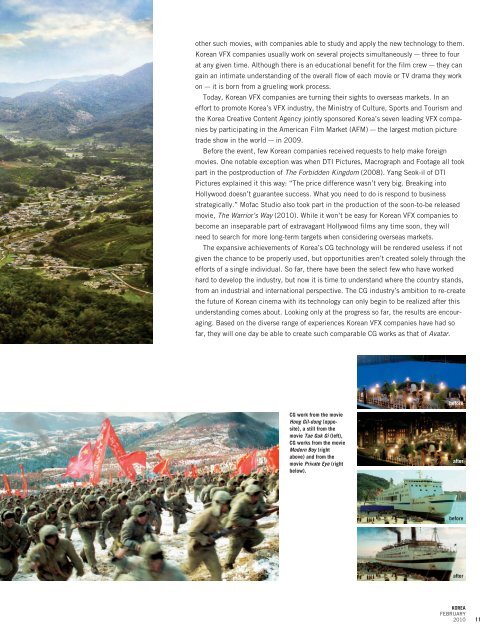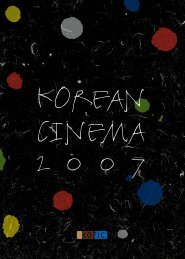www.korea.net
KOREAN MOVIES - Korea.net
KOREAN MOVIES - Korea.net
- No tags were found...
You also want an ePaper? Increase the reach of your titles
YUMPU automatically turns print PDFs into web optimized ePapers that Google loves.
other such movies, with companies able to study and apply the new technology to them.<br />
Korean VFX companies usually work on several projects simultaneously — three to four<br />
at any given time. Although there is an educational benefit for the film crew — they can<br />
gain an intimate understanding of the overall flow of each movie or TV drama they work<br />
on — it is born from a grueling work process.<br />
Today, Korean VFX companies are turning their sights to overseas markets. In an<br />
effort to promote Korea’s VFX industry, the Ministry of Culture, Sports and Tourism and<br />
the Korea Creative Content Agency jointly sponsored Korea’s seven leading VFX companies<br />
by participating in the American Film Market (AFM) — the largest motion picture<br />
trade show in the world — in 2009.<br />
Before the event, few Korean companies received requests to help make foreign<br />
movies. One notable exception was when DTI Pictures, Macrograph and Footage all took<br />
part in the postproduction of The Forbidden Kingdom (2008). Yang Seok-il of DTI<br />
Pictures explained it this way: “The price difference wasn’t very big. Breaking into<br />
Hollywood doesn’t guarantee success. What you need to do is respond to business<br />
strategically.” Mofac Studio also took part in the production of the soon-to-be released<br />
movie, The Warrior’s Way (2010). While it won’t be easy for Korean VFX companies to<br />
become an inseparable part of extravagant Hollywood films any time soon, they will<br />
need to search for more long-term targets when considering overseas markets.<br />
The expansive achievements of Korea’s CG technology will be rendered useless if not<br />
given the chance to be properly used, but opportunities aren’t created solely through the<br />
efforts of a single individual. So far, there have been the select few who have worked<br />
hard to develop the industry, but now it is time to understand where the country stands,<br />
from an industrial and international perspective. The CG industry’s ambition to re-create<br />
the future of Korean cinema with its technology can only begin to be realized after this<br />
understanding comes about. Looking only at the progress so far, the results are encouraging.<br />
Based on the diverse range of experiences Korean VFX companies have had so<br />
far, they will one day be able to create such comparable CG works as that of Avatar.<br />
before<br />
CG work from the movie<br />
Hong Gil-dong (opposite),<br />
a still from the<br />
movie Tae Guk Gi (left),<br />
CG works from the movie<br />
Modern Boy (right<br />
above) and from the<br />
movie Private Eye (right<br />
below).<br />
after<br />
before<br />
after<br />
KOREA<br />
FEBRUARY<br />
2010<br />
11
















